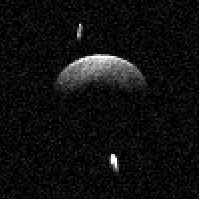Emily Lakdawalla • Feb 13, 2008
Triple near-Earth asteroid discovered
Astronomers using the soon-to-be-closed(?) Arecibo observatory announced today the discovery of the first near-Earth object known to be a triple system. Asteroid 153591 (2001 SN263) was first discovered as a mote of light by the LINEAR project on September 19, 2001. Asteroid 153591 (2001 SN263) is now on a relatively close pass by Earth; it'll approach within 10 million kilometers on February 20. (Here's a link to the JPL Near Earth Object Program dynamic orbit diagram.) Arecibo is routinely used to study the shapes and sizes of near-Earth asteroids on close approaches to Earth, and Arecibo radar images of such asteroids have yielded the discoveries of numerous binaries among the near-Earth asteroid population. But this is the first time it's turned up a triple system. The three bodies are 2, 1, and 0.4 kilometers across -- really quite remarkably similar in size. It's hard for me to imagine how such a system would be stable, unless one of the components orbits the others at quite a great distance. The release didn't make it clear what the separation is between the components.

Arecibo Observatory
Triple asteroid 153591 (2001 SN263)
Observing a close pass of asteroid 153591 (2001 SN263) on February 11, 2008, astronomers discovered that it was a triple system. This image from the Arecibo radio telescope shows all three components. The three are rather similar in size: 2, 1, and 0.4 kilometers in diameter.Let’s Go Beyond The Horizon
Every success in space exploration is the result of the community of space enthusiasts, like you, who believe it is important. You can help usher in the next great era of space exploration with your gift today.
Donate Today

 Explore Worlds
Explore Worlds Find Life
Find Life Defend Earth
Defend Earth

